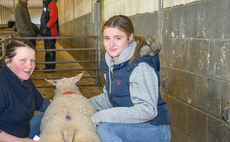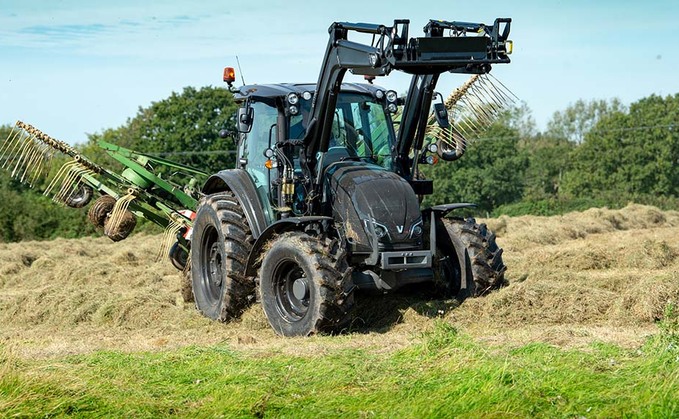
Following on from our original test drive of Valtra's A4 tractor series, we try out the latest version, now with the option of a semi-powershift gearbox. James Rickard reports.
When Valtra first launched its all-new A4 tractor series back in 2018 we were suitably impressed with its stylish, yet simple characteristics. A test drive soon after confirmed our initial enthusiastic perception of the tractor, but highlighted a few areas where the machine could be improved.
One such area was the gearbox, which when launched was limited to a 12 by 12 synchromesh unit. While this fitted in perfectly with the simple nature of the tractor and its intended use, for us and many others, it would appear, it was just a tad too limiting for some jobs.
As we found with our initial test drive, the 12 by 12 was great for yard work and, to some extent, field work, but for some jobs, such as pto work, we often found the ‘spacing' between the gear ratios meant you were either about half a gear too fast or half a gear too slow.
Not ones to ignore feedback, the manufacturer rocked up at the LAMMA Show in 2020 with the HiTech 4 version of the tractor featuring a 16 by 16, four-speed powershift gearbox. In addition to this, the firm recently introduced its fifth generation of A Series tractors, now with the option of HiTech 2 which brings with it a 24 by 24, two-speed powershift.
To find out more about the new HiTech 4 option and what impact its 16 by 16, semi-powershift gearbox has on the A Series, we tried out the 110hp A114 (now 115hp A115) HiTech 4 model, carrying out a mix of silaging tasks including tedding, raking, bale wrapping, bale carting and loader work.
A Series overview
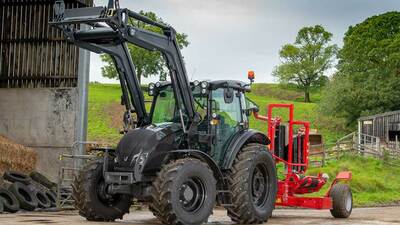
As mentioned, since our test drive, the A Series is now in its fifth generation. Seven models make up the series, now ranging from 75-135hp.
Power for all models comes from Stage 5 Agco Power engines, with a 3.3-litre, three-cylinder motor in the three smallest models and 4.4-litre, four-cylinder engines used in the two medium frame and two large frame models. These four-cylinder models all get a power hike by 5hp, now corresponding to the model number; an A135 is 135hp, for example.
While all A5 Series models can be ordered with a 12 by 12 synchromesh gearbox, the three smallest models (A75, A85 and A95) can be specified as HiTech 2 machines. These get a 24 by 24, two-speed powershift gearbox - essentially it is the 12 by 12 synchromesh with a ‘splitter' in each gear. A further 16 by 16 semi-powershift option is also available on the two mid-models (A105 and A115). And it is this HiTech 4 version our test drive focusses on.
At the top end of the series, the A125 and A135 have to make do with the 12 by 12 synchromesh box only. Valtra's reasoning being that if you want greater transmission choice with more power, then this is where the new G Series fits in.
Hydraulics-wise, all A5 models get mechanical spools, with up to three, double-acting valves. Conveniently, a simple tap can be used to divert oil flow from number two valve to the pickup hitch, to push it in and out.
Hydraulic flow rate for this tractor is a generous 98 litres/minute, which is good for this size of tractor. For loader work, in particular, it means you can keep the revs down and still have swift loader actions. If flow rate for some jobs is too high, one of its twin pumps can be disengaged via the press of a switch, almost halving oil flow.
Cab and controls
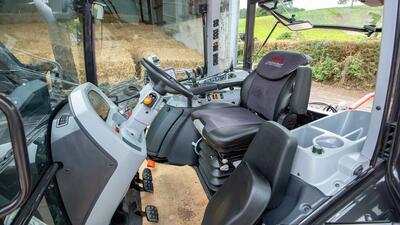
As we found last time, we like the well laid out, comfortable, spacious cab of the A Series. It also boasts good visibility all-round and features a handy bit of storage.
The main visual difference in the HiTech 4's cab is the gearbox control. Instead of a main gear lever coming up out of the floor and another lever for the range change, HiTech 4's gearbox is controlled by a fixed lever, mounted on the right and console.
Incorporated into this fixed lever are rocker switches for both the range changes and the powershift changes. There is also a button for declutching.
The lever falls within easy reach and is well shaped to fit your hand. It also gives you something solid to swing off, should the terrain get a bit rough.
Cab and controls 2
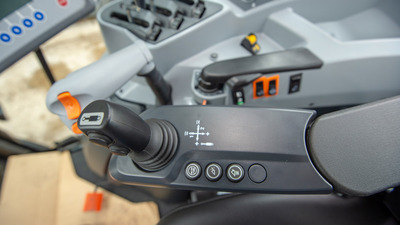
Compared to the last A Series test drive, this time the tractor came with electro-hydraulic loader controls, with a small joystick integrated into the tractor's armrest (pictured above).
Though small, this ‘stick offered really good proportional and accurate control over the loader. The end of the armrest, which the joystick is incorporated into, can also move sideways to help get it in a position of your liking - it could not be placed any better.
Comfort-wise, while there is no front axle suspension option throughout the A Series, HiTech 4 does bring with it the option of having mechanical cab suspension. As we found, it is a ‘nice to have' feature, especially when shifting bales across a field. This, coupled with the loader's suspension system, made bale shifting that bit more comfortable.
Transmission features
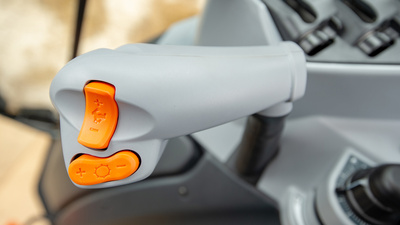
In terms of what is under your feet, HiTech 4's gearbox is made up of four ranges with four powershift gears in each range. There is also the option of a creeper gear.
Like many powershifts on the market these days, HiTech 4 does feature several operating modes. Activated by a rocker switch on the right hand B pillar, you can select manual, Auto 1 or Auto 2. For simplicity, each automatic mode features pre-set points at which the gearbox will change up or down.
In Auto 1, upshifts occur at 1,650rpm, while in Auto 2 these happen at 2,050rpm. As such, this makes it very easy to select the most appropriate mode for the job (see performance panel for more). Though, you still have to make manual range changes in the automatic modes, which is not exactly a hardship.
Transmission features 2

If you still want to customise the gearbox further to either your liking or the job at hand, you can pre-programme a start off gear. You can also set a difference between gears when changing from forwards to reverse. For instance, when loading a spreader out of a muck heap, you may want a low gear for pushing into the pile of muck, but a gear or two higher for when shuttling backwards.
You can also ‘clear' the start off gear setting and the tractor will just stay in the gear which was used last. However, by pre-setting a forward and reverse gear, the tractor will know which gear it needs to be in before you have changed direction, making shuttling a little snappier.
In addition, you can go through the dash and alter the aggression of shuttling and gear changes. And if all that is not enough for you, it also has a ‘brake to neutral' feature, called AutoTraction, whereby the clutch will automatically be pulled in when the brakes are pressed.
Powershift performance
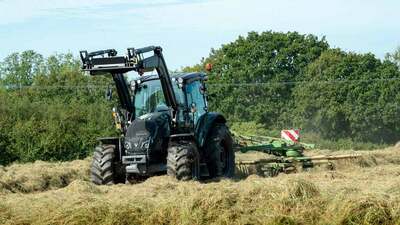
Thanks to a variety of jobs, we really got to know the ins and outs of the transmission, with different scenarios highlighting different aspects of the transmission.
Tedding and raking showed off what the powershift brings to the party for pto work. Granted, the new gearbox option only brings with it four more gears, but these are just enough to offer a ‘tighter' gear spacing, resulting in the ability better match forward speed to the job. And because it is a powershift, it also means this can be done more easily than with a synchromesh ‘box.
Powershift changes are pretty snappy, as are range changes, which is certainly impressive for a tractor of this size. As for the operating modes, we tended to stick with manual mode for pto work and bale wrapping, giving that absolute and predictable control over speed.
Bale wrapping brought into focus the ability to keep the revs, and therefore the necessary oil flow, at a constant, by relying more on the transmission to alter forward speed, rather than the throttle. Again, the convenience of being able to conveniently rattle up and down the gears as necessary is a big bonus of the powershift.
Powershift performance 2
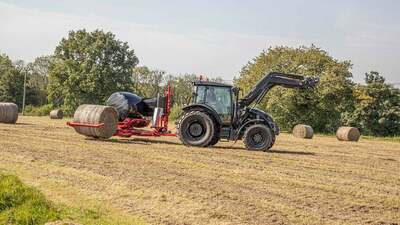
Bale loading and carting gave us a chance to explore the automatic modes and their gear changing characteristics. As we found, Auto 1 is good for transport work when a trailer is empty, for instance. In this mode, the gearbox will ‘short shift', as you would when running un-laden, with no need to rev the engine hard, saving fuel in the process.
We also found Auto 1 to be useful when loading bales in the field - you can literally just keep your right hand on the loader controls and leave the gearbox to sort itself out. At the other end of the scale, Auto 2 is suited to heavier-duty transport work, allowing the engine to ‘rev out' before a gear change is made, making the most of the tractor's power.
As for the brake to neutral feature, this is a handy little feature and is ideal for basic loader work or for some transport duties, when the gearbox is used in automatic. Thankfully, this feature can now be turned on and off on the new A5 models, unlike our A4 test subject where it was always on.
Verdict
Overall, the introduction of the HiTech 4 specification and its 16 by 16 semi-powershift gearbox is a great addition to the A Series.
It does as promises and brings with it more gears to play with and more operator convenience. It is also very simple to use and packs some useful and non-complicated features.
However, it does seem a shame HiTech 4 is not available on the top two A Series models, but we can understand Valtra's reasoning.
























